Sumo wrestling is Japans national sport. If you are visiting Tokyo make sure to reserve some time for watching a match. I show you how to get in and where to get tickets.
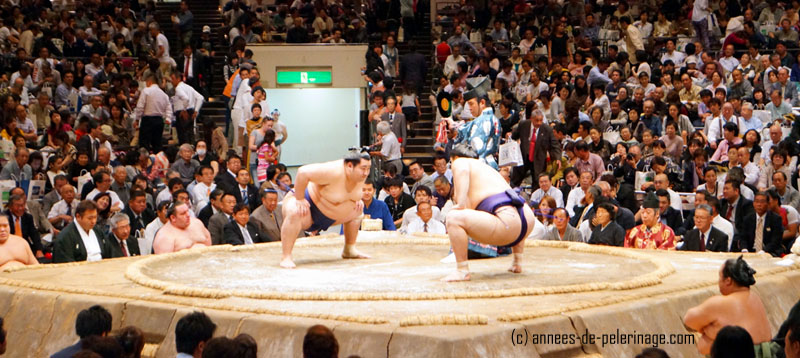
Sumo wrestling: No other sport is so readily identified with the Japan and most people abroad will have heard of the big sportsmen and the sophisticated rituals that accompany each match. As a tourist you only got a few chances to actually attend to one of the rather rare sumo wrestling tournaments – so you better prepare in advance. But definitely make sure to put in into your Japan itinerary (<- click to read mine)
_________
Looking for other things to do in Tokyo? How about:
Enjoying Tokyo’s best view from Mori Towers
Or visiting Meiji Shrine – Tokyo’s biggest shrine
When are sumo tournaments held?
Sumo wrestling is no sport you can watch the whole year. While not totally comparable to the soccer premier league, there is an official tournament season with official breaks in the schedule. That being said, there is actually a high chance that you won’t be able to see a sumo match during your visit simply due to the fact that none is scheduled during that month.
The good news is that each year’s sumo tournament seasons follows a precise and predictable pattern: It will start in Tokyo in January and continue in Osaka in March. Then the tournament will return to Tokyo in May, following up with Nagoya in July, and back again to Tokyo in September. The official tournament season will end in Fukuoka in November. Each of these tournaments lasts for exactly 15 days. Starting on the second Sunday of the month and ending on Sunday two weeks later. There is an official Schedule of the Japan Sumo Association you can check for more information.
If you plan well ahead it’s possible to get tickets quite easily. Tickets for the weekends will be harder to get out of obvious reasons. I’ll come back to the ticket issue later.
What to do if there is no official tournament during my stay?
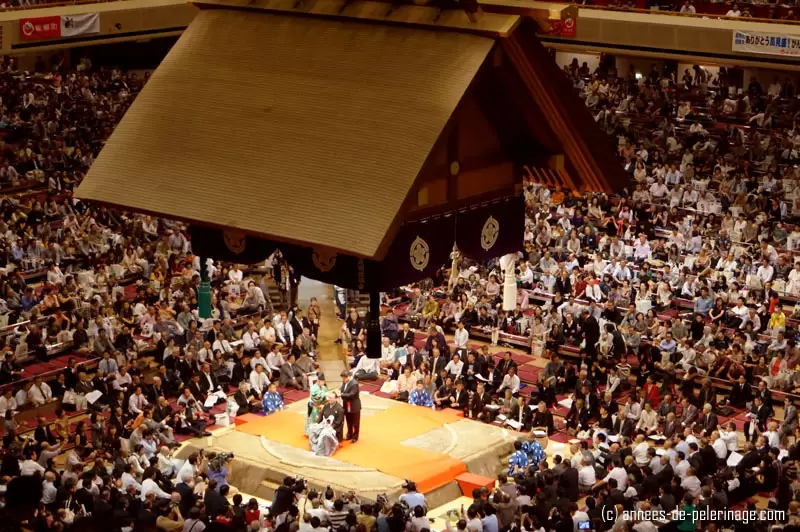
Well, bad luck I’d say. Then you will have only a scant few alternatives. Aside from the grand tournament (which translates to something like the sumo wrestling champion league) there are other, less popular sumo wrestling events you can attend. On occasion, there will be amateur matches or retirement matches for very famous sumo wrestlers ending their career.
The atmosphere at these events, however, will be less frenetic and a little bit more low-key. Also if you attend a retirement ceremony most of the time will be spent on the endless announcement and a veeeerrry prolonged ceremony. Basically, everyone the retiring wrestler ever said hello to will come into the ring one after another and cut away a tiny strand of his long black hair. Later on, there will be a sumo match.
Watching sumo practice in Tokyo
You could also visit one of the sumo wrestling stables and watch the morning practice of the wrestlers. Some stables actually got their own website with information in English (like arashino). Morning practice, or keiko how it’s called in Japanese, will typically start around 7:00 am and last until 10:00. Due to the high demand for tourists and the limited space in the gyms, you might have problems getting in. So be there early and better ask your concierge for guidance if you don’t speak Japanese. Also be aware that morning practice usually won’t be held during tournament season and on some national holidays.
Where to buy tickets for a sumo match
Buying tickets for a grand sumo tournament is actually quite easy. Just to go the official website and walk through the steps. Tickets go on sale roughly one month before the actual tournament. You will have to pay with credit card, though. Once purchased you will be able to redeem your tickets at the stadium using the credit card you paid with. Please do not forget it since it’s your only legitimization at the vending machine.
If this sounds too much of a hassle, you can also make use of a ticket broker. For my last visit, I used www.buysumotickets.com and everything worked out fine. They can either ship your tickets to your home address or to your future hotel in Tokyo. I did the latter without any problems at all. (Buying tickets via the official website will probably be cheaper though).
Which tickets should I buy for the sumo arena in Tokyo?
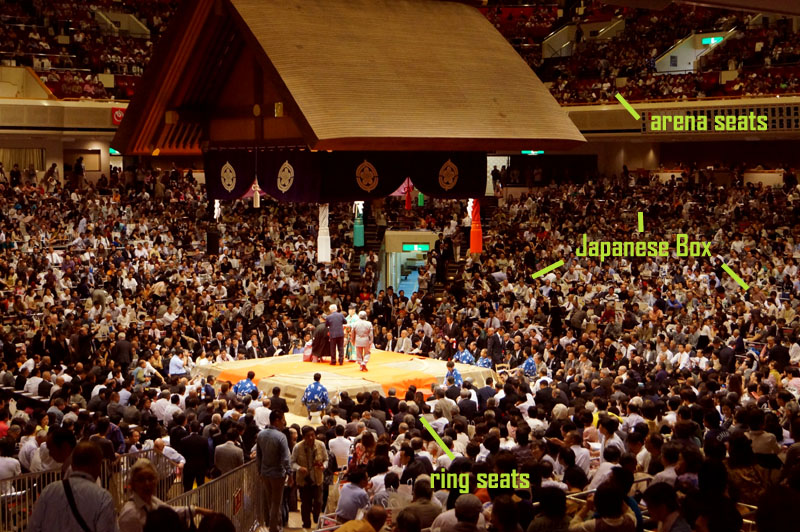
There is only one official sumo wrestling stadium in Tokyo – the Ryogoku Kokugikan. Inside the sumo arena, there are only two different kinds of seats available: the Japanese box and the arena seat (okay I lied – there are also the ring seats, but you won’t be able to get these VIP tickets). The sumo arena consists of a lower floor and an upper balcony tier. Arena seats are basically normal western stadium seats and will be located high up on the balcony. What they call ‘Japanese box’ are traditional Japanese seats where you will sit on the floor. These are located on the ground floor and offer the best view.
A word of warning: Most western people can’t sit on the floor for a longer period. There are no single tickets on sale for the ground floor. You will have to get a box officially suitable for 4 persons. Except you are really sure you can sit on the floor Japanese style for a couple of hours – do not book a box for more than two people. You will definitely need the extra room to stretch your legs! Even for the small Japanese, the box is a tight fight for four people.
Can’t I just get the cheaper seats on the balcony?
The Kokugikan is very big and the balcony is quite high above. Even if you get seats on the front row of the balcony you will see the sumo wrestlers from quite far away. If money is no consideration – go for the seats on the lower floor.
You will, however, be able to move around the arena more or less. In fact, the tickets allow you to leave the entire arena complex once. So especially if you only got bad tickets high up on the balcony, you should try and leave your seats and walk around a bit. There is a high chance you can sneak into the lower floor and watch the sumo wrestlers a while from the aisles – especially earlier in the morning. Depending on the time you are attending the match, a big portion of the arena will be empty anyway. So just pick an empty seat with a good view and kindly excuse yourself if someone shows up with tickets for that seat later on.
What to expect from sumo wrestling
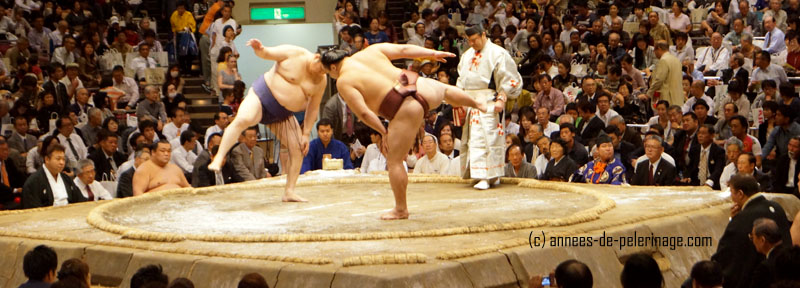
Sumo is a sport where two wrestlers are trying to shove each other out of the ring. The other alternative to winning is making the opponent touch the ground. Despite looking fat, if not actually obese, sumo wrestlers are very strong, very fast and incredibly flexible. In fact, a huge portion of the ritual before each match is dedicated to showing off just how flexible they are (the combatants will repeatedly lift their massive legs high up in the air and stomp on the ground).
A sumo wrestling match typically just lasts a couple of seconds that will be accompanied by the loud comments of the judge – the rest of the match time is left to rituals. Sumo wrestlers seem to be a very superstitious lot. So expect them to repeatedly spill salt on the arena floor (for ritual cleansing and against malicious spirits), measure each other’s strength, flex their legs, then deciding it is not the time for the short bout yet and entering another round of tossing some salt, foot stomping and starring at each other. This can go on for minutes and actually will start to get boring after a time.
There are quite a few highlights on each tournament, though. Since they operate on a rather regular schedule, you can plan your visit accordingly.
Sumo wrestlers are divided into different divisions (this is comparable to the soccer leagues). The higher up you are in the divisions the better you are. The top divisions will have their matches at the end of the day, while amateurs will fight very early in the morning.
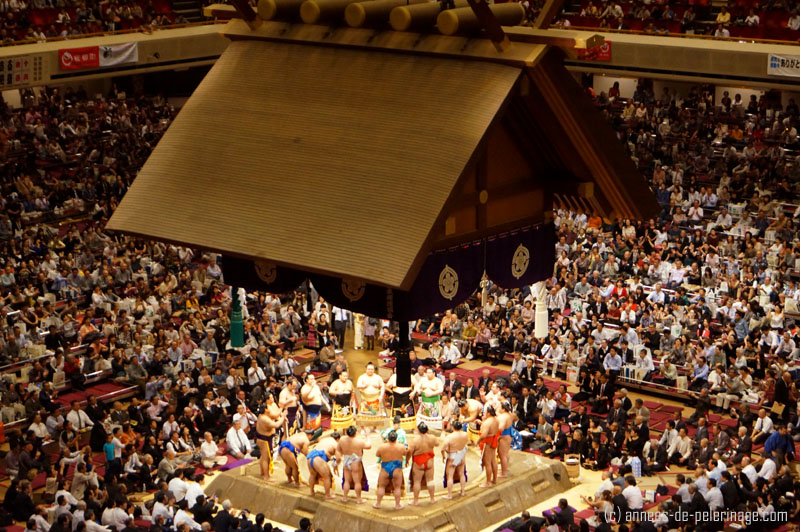
The doors to the sumo arena will open at 8:00 am with the first match starting at 8:30 am. I recommend you to come around 3:00 pm to 3:30 pm so you will be able to see all highlights in the top divisions.
- Around 3:45 pm the makuuchi (top division) wrestlers enter the arena. They will do that wearing special loin clothes and performing some kind of dance – a ceremony you don’t want to miss.
- Around 4:15 pm the first matches of the top division will commence. The last match will be around 5:30pm
- Then there will be a short break and the tournament day will end with the bow-twirling ceremony at around 6:00 pm (yes it involves an actual bow).
There is an official sumo guide in English with more details on the regular schedule.
I really have to stress that you shouldn’t come too early to the arena (except you are a true sumo fan). The real fun starts in the evening. You could probably be there in the morning, though, leave the arena for a short trip around the Sumida ward and come back later on again. Since there is so much to see in Tokyo, I do not recommend you to spend the whole day at the sumo wrestling arena. Rather use the morning to see other tourist attraction. The Tsukiji Fish Market comes to mind since it only operates in the morning hours anyway (read my guide here).
How to get to the Ryogoku Kokugikan in Tokyo
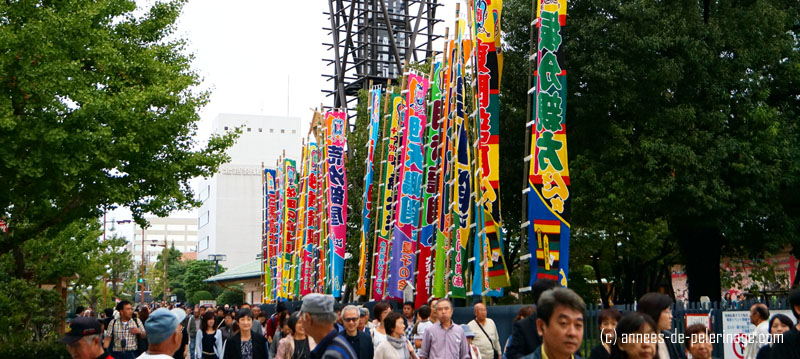
The sumo wrestling arena is located in the Sumida ward and is easily accessible by metro. You will have to get on the JR Sobu Line (that’s the yellow/orange one on the maps) and get out at Ryogoku Station. Once there you really can’t miss the Kokugikan – it’s the huge ugly greenish building that somewhat reminds you of an Inca pyramid or a large tent (you will be able to see it from the metro exit). On tournament days the road leading to the arena will be decorated with colorful banners and there will be a lot of people going in and out – so you might as well follow the crowds.
Can I bring my own food and drinks to the sumo wrestling tournament
If you are asking this question, you have probably never been in Japan before. Of course, it is possible to bring your own food and drinks to the sumo match – just like in virtually every other public place in Japan. In fact most Japanese do and I encourage you to do so too. The whole arena will be full of people with their chopsticks in the one hand and a bento box in the other hand watching the match. No need to stick out, eh?
There are a couple of food stalls at the sumo wrestling arena as well. So even you didn’t bring anything along you can buy a little snack during the sumo tournament. There are long breaks in between the fights of the different divisions to give you more than enough time to do so without missing anything at all.
On a side note: Actually, I heard that drinking and eating are in fact forbidden at the match. But nobody ever seems to enforce this rule!
Last but not least a little bit of Japanese
Sumo is actually pronounced su-mooooooooO – with the emphasis on the stretched o. Japanese probably won’t understand you, if you try to pronounce it the English way. That is why in proper transliterations sumo will be spelled with a long o – like that: sumō. Sumo – sorry sumō wrestlers are called rikishi and the early morning practice at the sumo wrestling stables are called keiko. The frequent salt tossing during the matches is called kiyome no shio. The wrestling ring itself is referred to as dohyo. And last but not least: the ceremonial loincloths of the wrestlers are called kesho-mawashi.
Hope my little guide to watching sumo wrestling matches in Tokyo helped you plan your visit! Oh! And remember to tell me how you enjoyed it afterward! You’ve seen a match already? Share your experience down in the comment section!
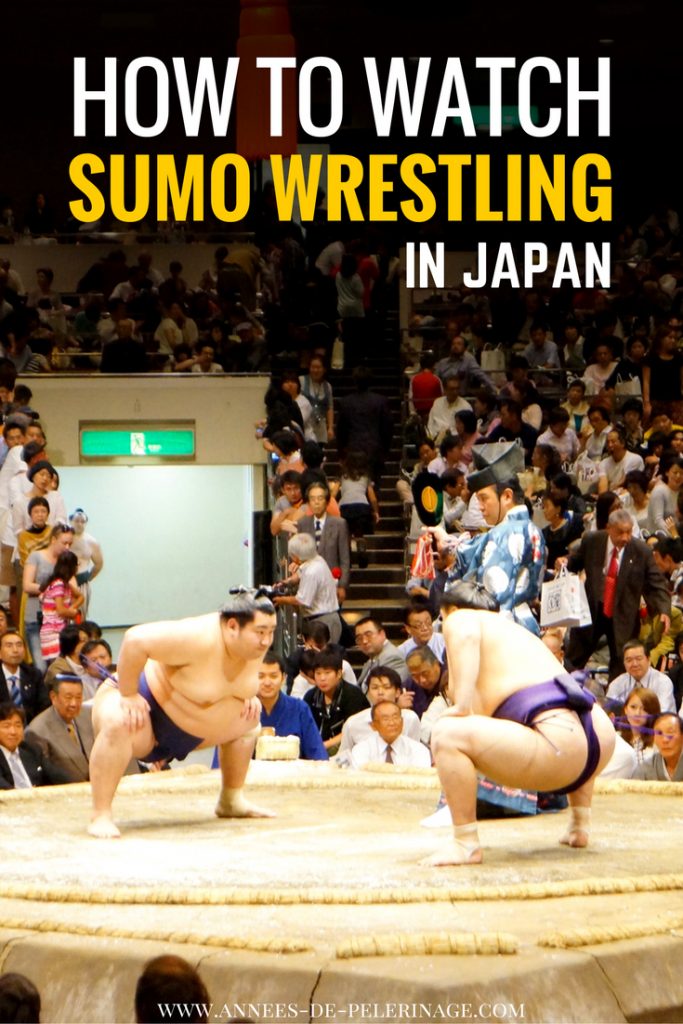
Planning a trip to Tokyo? Remember to check out the Imperial Palace in Tokyo. You need to book tickets in advance – so better read my guide!


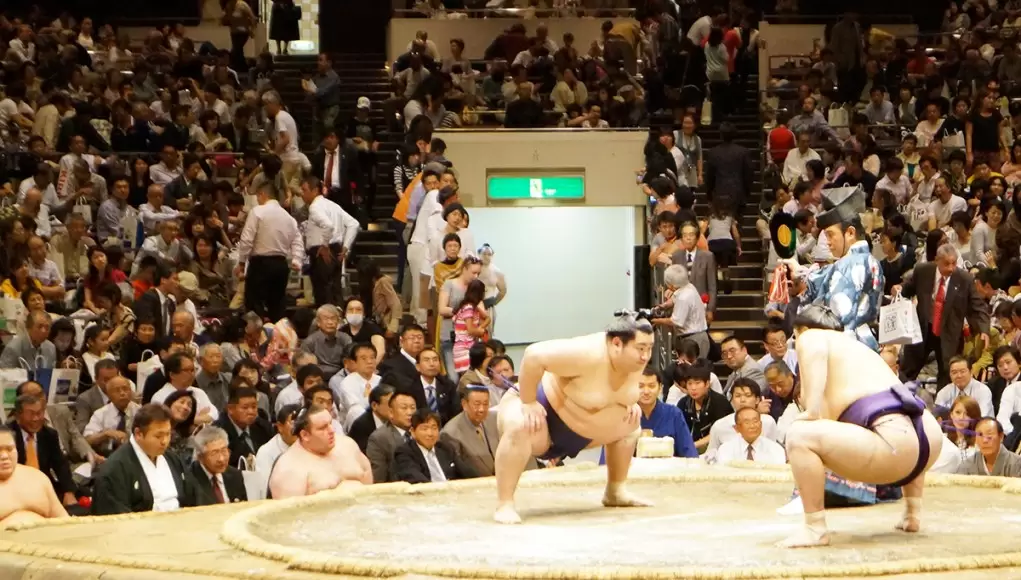
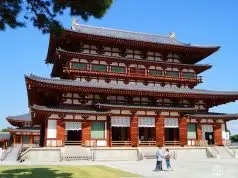
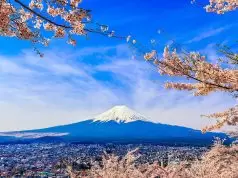
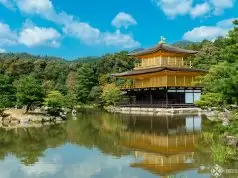


This is a great guide, thank you! On our trip this past May we started watching the sumo every evening on TV and would love to go to watch live on a future trip. :)
I will have a toddler aged 3 years with me, is it ok to take her?
Hey Pooja,
actually, bringing babies is a long tradition, so it’s probably no problem. BUT not sure where to store your pram.